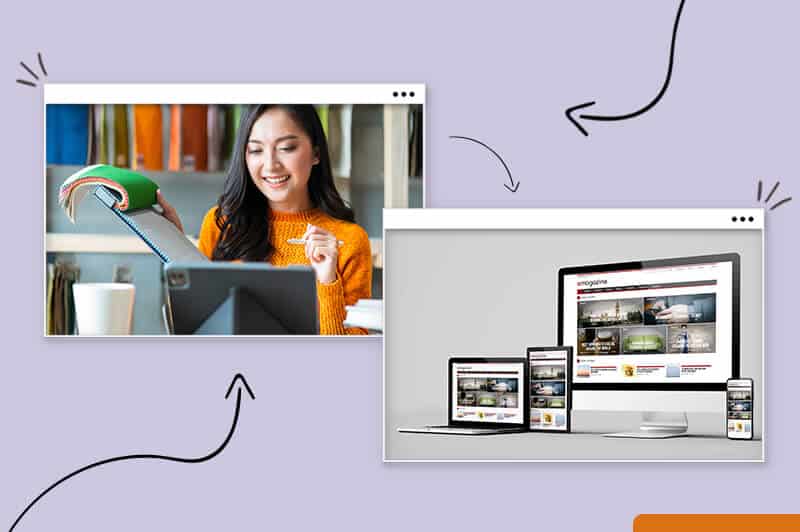
Whether you’re just starting your small business or have already been in business for a while, there’s no doubt that you face challenges along the way. Even if you’ve done everything right, you know the universe always finds a way to throw you a curveball (gotta love the universe).
But this doesn’t mean you should give up. Challenges are a normal part of doing business. Instead, it’s important to educate yourself and learn what common challenges small business owners face and how to overcome them. And this post is going to talk about just that.

I don’t want to waste your time – you have a business to run! So, let’s cut to the chase and talk about the common challenges small business owners face and the ways to overcome them. You ready?
As a small business, you’re starting from scratch, and finding new customers can be a challenge. Since you’re working with a minimal marketing budget, every dollar counts.
Advertising to the wrong audience could result in 1) no new customers and 2) wasting your marketing budget – and these are two things you don’t want to happen.
Before you start marketing your business, you need to have a plan and outline of your business and audience. Without this information, your business will be floating in the wind. A strong marketing strategy is the foundation for any successful business.
A marketing strategy includes competitor research, an audience persona, which data analytics you’ll use to measure your metrics, your goals, and more. All this information creates a stable base for your business to grow.
For a step-by-step guide on creating a marketing strategy, read this post.
An email newsletter is a great way to build customer relationships and move customers through the buyer’s journey, the path a customer takes to make a purchase.
While email marketing is the most effective marketing channel, it’s easy to lose steam and run out of fresh content for your email subscribers. Some businesses take shortcuts and buy email lists. But honestly, it’s a huge waste of money and doesn’t consist of authentic customers.
An opt-in email list is made of subscribers who voluntarily give their email addresses so you can send them emails. You can achieve this by having pop-up notifications on your website asking for customer emails, offering discounts and incentives for customer emails, or by offering engaging content in exchange for their emails.
Once you have customer emails, now it’s time to send them engaging content! To create eye-catching emails newsletters, you can use the following email marketing tools:
Whether you’ve launched a business or are just starting out, cash flow is always a problem for small businesses. You don’t have a lot of money to throw into your business, and yet, it’s easy for the bills to pile up.
Plus, the odds are you don’t have a large customer base yet, so you’re still working on gaining regular and consistent sales. Many small business owners don’t account for the lack of cash flow when starting their business and end up on thin ice.
No one likes budgeting, but when you’re a business owner, it’s a necessity. Writing down your expenses and having a firm understanding of the costs of running your business will help you see what you’re spending money on.
If budgeting isn’t your thing (which I totally get), invest in a bookkeeper or accountant. They will be able to help you create a budget for your business and guide you through financial planning.
You’ve put in the hard work of building your business, and you have a bomb product, but no one knows you exist. To solve this problem, you need to increase brand awareness, helping consumers become familiar with your business. With brand awareness, you generate trust, build a loyal customer base, and gain product/service recognition.
Brand awareness will help your business grow. But the secret to growing your business is by focusing on the right details of your business.
For example, you may be scared to launch your business because you don’t think your product is perfect. But having a perfect product isn’t as important as marketing your business, for example.
There are certain details of your business that will be a work-in-progress, like product development. Once your product is out there and purchased by customers, you’ll learn what’s working and what’s not. However, to get eyes on your product, you need to get attention from customers.
But how does your small business grow and become a recognizable name?
There are many ways you can increase brand awareness online; here are some examples:
Blogging: Having a high-quality blog will also help build your brand awareness. A blog will drive visitors to your website and help convert visitors into sales. It’ll also help establish your business as an authority in your industry (which attracts prospective customers as well) and build your email list.
Small business collaboration: You’re not the only small business out there, so why not collaborate with other businesses? Connect with local or online businesses that you feel will compliment your business and vice versa. They can post content about your business on their social media channels, and advertise your product/service to their customers.
User-generated content: Why work harder when you can get your customers to increase your brand awareness for you? User-generated content is a successful method to increase brand awareness. Customers post photos, reels, and stories on their social media channels, advertising your product/service. Offering incentives or discounts for customers who post your product/service online can help.
As a small business owner, you’re wearing all the hats. You’re the product/service developer, social media marketer, bookkeeper – you’re doing it all (pat yourself on the back, by the way).
That said, you only have so many hours in a day and there’s a chance that you also have your day job. So, you don’t have endless hours to dedicate to building your business. That said, time management is crucial. You want to make sure every minute spent on your business is being used efficiently.
First, take a breath. It’s easy to feel overwhelmed, but you got this. All you need to do is organize your time. Write down all the tasks you need to complete. Then establish priority. What are the most important tasks to complete? Are you able to complete them yourself?
If you feel you have too much on your plate, consider outsourcing some administrative tasks. For example, you may need to focus on product development, but you also have to update your website. If it’s too much, you can outsource your website design task to a freelancer.
If you’re interested in outsourcing, check out this post for a list of recommended outsourcing websites.
If these past few years have taught us anything it’s that the world can change instantly. Whether it’s economic instability or COVID-19, these events have shaken up the world.
All these events can make running a business feel unstable, and frankly, stressful. While we can’t do much to prevent these events from happening, you are in control of how you react to them as a business owner.
As a small business owner, you don’t have millions of dollars to sit on if something goes wrong. And let’s be honest, even big businesses have backup plans. While you may not be able to determine when an unfortunate event will arise, a backup plan can help you feel more prepared.
You can create a plan or come up with ideas around what to do in case of an emergency (like another pandemic) to help keep your business survive.
A good rule of thumb is to have at least 3 months’ worth of business expenses saved. This will keep your business afloat during slow periods. So, for example, if your business expenses are $500 each month, you should have $1500 in your emergency business fund.
Many small business owners feel they can’t take time off. You’re running a business, you just can’t leave it, right? What will happen to it?
But the reality is, you’re human. And everyone needs a break. Taking time off is essential, not only for yourself but for your business. Taking that time to recharge may inspire you with new ideas for your business.
Okay, I know, I know – just take time off. Easier said than done. While you may not have the budget to hire someone while you’re away, you can still go on vacation. The only difference is, as a business owner, you’ll need to plan ahead and create a system for yourself.
For example, if you’re going away for 2 weeks, set up your email to auto-reply telling customers you’re on vacation, complete any orders you have prior to going to prevent backlog, and possibly hire a Virtual Assistant to stay active on your social media or customer queries.
Everyone goes on holiday, why shouldn’t you?
Like I said before, you’re a small business owner, one that’s wearing all the hats (is it me, or do small business owners have a thing for hats?). But seriously, when running a business, it’s easy to get burned out.
You have your business, possibly your day job, and all the other responsibilities that come with life. You know the saying, you can’t pour from an empty cup. If you want your business to succeed, you need to put yourself first.
I know, it’s easier said than done. But, working on creating a work-life balance can help you avoid burning out. Creating a work-life balance includes:
Understand your priorities: Here are the steps to help you learn what your priorities are:
By understanding your priorities, you’ll have clarity on what’s important to you as a person and business owner. That way, you’ll be able to know where you should invest your time and what things you can pass on to a freelancer or Virtual Assistant.
Not having to carry the entire business on your shoulders will give you a better work-life balance.
See if you can outsource administrative tasks: If you’re noticing you’re spending too much time on specific tasks because you don’t like them (for example, bookkeeping), consider whether you should outsource this task. Yes, you’ll have to spend some money, but if it’s taking you hours to complete the task, perhaps that time will be better spent working on other aspects of your business.
Invest time in yourself: Yes, you’re a business owner but that shouldn’t overtake your entire life. Schedule time out every day that’s dedicated to you. Whether it’s reading a book, working out, going for a coffee with your best friend, or having date night – however, you choose to spend this time is up to you. What’s important is that you’re investing in yourself.
Since you’re a small business owner, you wear a lot of hats. But knowing the possible challenges you may face can help you prepare and avoid them.
Reflect on your business and see if you’re running into any of these challenges. Now that you know the solutions, you can improve your business.
This portion of our website is for informational or educational purposes only. Tailor Brands is not a law firm, and the information on this website does not constitute legal advice. All statements, opinions, recommendations, and conclusions are solely the expression of the author and provided on an as-is basis. Accordingly, Tailor Brands is not responsible for the information and/or its accuracy or completeness. It also does not indicate any affiliation between Tailor Brands and any other brands, services or logos on this page.
Products
Resources
©2025 Copyright Tailor Brands